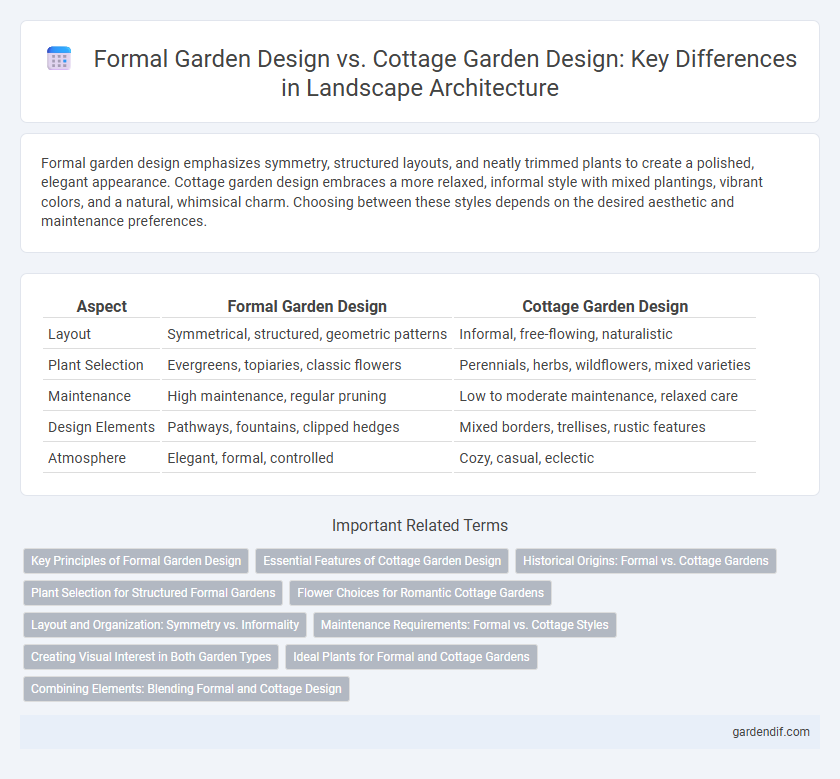
Formal Garden Design vs Cottage Garden Design Illustration
Formal garden design emphasizes symmetry, structured layouts, and neatly trimmed plants to create a polished, elegant appearance. Cottage garden design embraces a more relaxed, informal style with mixed plantings, vibrant colors, and a natural, whimsical charm. Choosing between these styles depends on the desired aesthetic and maintenance preferences.
Table of Comparison
| Aspect | Formal Garden Design | Cottage Garden Design |
|---|---|---|
| Layout | Symmetrical, structured, geometric patterns | Informal, free-flowing, naturalistic |
| Plant Selection | Evergreens, topiaries, classic flowers | Perennials, herbs, wildflowers, mixed varieties |
| Maintenance | High maintenance, regular pruning | Low to moderate maintenance, relaxed care |
| Design Elements | Pathways, fountains, clipped hedges | Mixed borders, trellises, rustic features |
| Atmosphere | Elegant, formal, controlled | Cozy, casual, eclectic |
Key Principles of Formal Garden Design
Formal garden design emphasizes symmetry, geometric shapes, and precise, well-defined lines to create an orderly and balanced landscape. Key principles include the use of clipped hedges, topiary, gravel pathways, and structured plantings arranged in patterns such as parterres or allees. This style prioritizes control over nature, often featuring focal points like fountains or statues to enhance visual harmony.
Essential Features of Cottage Garden Design
Cottage garden design emphasizes informal layouts with dense plantings of flowering perennials, herbs, and climbing vines, creating a charming, naturalistic look. Essential features include winding pathways, mixed borders, and a focus on biodiversity with pollinator-friendly plants. This style contrasts formal garden design by prioritizing spontaneity and rustic appeal over symmetry and precise geometry.
Historical Origins: Formal vs. Cottage Gardens
Formal garden design originates from Renaissance Europe, characterized by symmetry, geometric patterns, and meticulous order, often seen in the grand estates of France and Italy. Cottage garden design, rooted in English rural traditions of the 19th century, emphasizes informal, naturalistic plantings with a mix of flowers, herbs, and vegetables, reflecting a more relaxed and utilitarian approach. These contrasting historical origins influence their distinct aesthetics and planting strategies in modern landscape design.
Plant Selection for Structured Formal Gardens
Structured formal gardens emphasize plant selection with uniform, evergreen shrubs such as boxwood (Buxus spp.) and yew (Taxus spp.) to create precise geometric shapes and defined borders. Seasonal flowers like tulips and annuals can be incorporated for color, but the primary focus remains on symmetry and repetition to maintain order and formality. Low-maintenance perennials with predictable growth habits are preferred to ensure the garden's clean lines and structured appearance throughout the year.
Flower Choices for Romantic Cottage Gardens
Romantic cottage gardens prioritize informal, densely planted flower choices such as roses, foxgloves, lavender, and hollyhocks, creating a lush, whimsical atmosphere. Unlike formal garden designs that use structured layouts and symmetrical plantings like boxwood hedges and tulips, cottage gardens emphasize perennial flowers and climbing plants that bloom in layers throughout the seasons. The organic mix of colors and textures in flower selections fosters a nostalgic, enchanting ambiance distinctive to cottage garden landscapes.
Layout and Organization: Symmetry vs. Informality
Formal garden design emphasizes symmetry, precise geometric shapes, and structured pathways, creating a balanced and orderly layout. Cottage garden design favors informality with irregular plant groupings, winding paths, and a more natural, relaxed organization that encourages a sense of spontaneity. The contrast in layout and organization highlights formal gardens' rigidity versus the cottage garden's charming, casual appeal.
Maintenance Requirements: Formal vs. Cottage Styles
Formal garden design demands regular maintenance, including precise pruning, weeding, and shaping to maintain its structured and symmetrical appearance. Cottage garden design allows for more relaxed upkeep with a focus on natural growth, requiring less frequent trimming and embracing wildflower blooms and informal plant groupings. The labor intensity in formal gardens is higher due to strict geometric layouts, whereas cottage gardens thrive with seasonal deadheading and minimal intervention.
Creating Visual Interest in Both Garden Types
Formal garden design creates visual interest through symmetrical layouts, geometric shapes, and structured plantings, emphasizing order and precision. Cottage garden design achieves visual appeal with informal arrangements, diverse plant species, and layered textures that evoke a natural, whimsical atmosphere. Both styles use color contrast and focal points, such as topiary in formal gardens or colorful blooms in cottage gardens, to engage the viewer's eye.
Ideal Plants for Formal and Cottage Gardens
Formal garden design features structured plant choices such as boxwood, yew, and lavender to create symmetrical shapes and clean lines. Cottage garden design embraces a more relaxed planting scheme, favoring colorful perennials like foxgloves, hollyhocks, and delphiniums alongside herbs such as thyme and chamomile. Both styles benefit from plants suited to their structure--formal gardens emphasize evergreen shrubs and clipped hedges, while cottage gardens thrive with mixed border plants and climbing roses.
Combining Elements: Blending Formal and Cottage Design
Combining formal garden design with cottage garden elements creates a balanced landscape characterized by structured lines and naturalistic plantings. Incorporating geometric pathways alongside informal, densely planted flower beds enhances visual interest while maintaining order. This blend leverages clipped hedges and topiaries with a diverse palette of perennials and flowering shrubs to achieve both elegance and charm.
Formal Garden Design vs Cottage Garden Design Infographic

 gardendif.com
gardendif.com